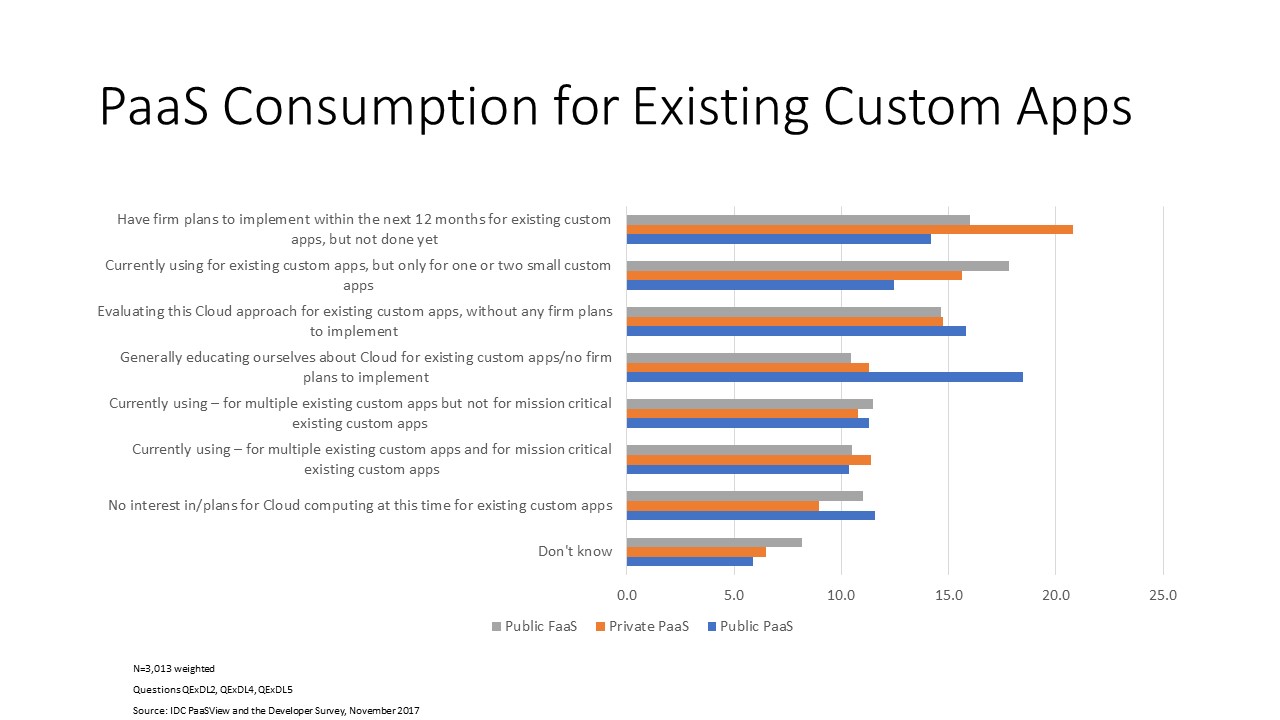While Platform-as-a-Service (PaaS) is more than 10 years old, the technology has not captured a level of market success commensurate with its mindshare – and has indeed lagged either SaaS or IaaS in terms of market presence. Yet in spite of its slow market growth, PaaS technology has continued to diversify and evolve to support the intensifying developer need for agility and productivity, especially as developers have assumed a front seat at the enterprise digital transformation table.
In the category of cloud platform services, PaaS market offerings tend to provide two general styles:
- abstraction in the deployment of standardized programming language code (deployment-centric PaaS mostly used by professional developers) and
- abstraction in the programming model focused on the ease of development (model-driven PaaS also known as low/no code).
Here, we are discussing the first style: deployment-centric PaaS that is fundamentally changing to embrace containers for running workloads and the serverless platform as the preferred application architecture.
So why are developers so wary of traditional PaaS approaches? Here are three concerns that keep developers from investing more in PaaS:
Is my PaaS flexible?
The solutions that businesses are trying to build often leverage machine learning/artificial Intelligence (ML/AI) capabilities, blockchain features and/or Internet of things (IoT) implementations. Traditional PaaS approaches are sometimes slow to offer broad availability of tools, languages and databases to handle the variety of challenges faced by these new and soon-to-emerge types of solutions required by businesses. As business challenges and associated solutions requirements vary, developers who start with an opinionated PaaS prefer an application architecture with a wide variety of tool choices that can cater to their needs and making appropriate changes in their platform strategy.
Am I locked in?
Several platforms can run on multiple infrastructures but at the end of the day, you still need the same PaaS vendor. Abstractions layered across the infrastructure over the raw and well-understood operating system interfaces tend to be non-standardized, leading to difficulty in migrating workloads between PaaS and infrastructure-as-a-Service (IaaS) environments. Depending on how many higher end services you may consume from the infrastructure vendor, portability may not necessarily be an easy process. Vendors provide developer capabilities on the higher end of the stack while abstracting the infrastructure layer but then capabilities are limited to PaaS features available from the chosen vendor.
Is my PaaS open?
While cloud is bringing open source solutions to the masses, not all initiatives have a code contribution mix that is evenly distributed among members, and the consumption of/use of open source software elements does not automatically mean a solution is truly open. The benefits of domination of an open source initiative by one vendor is that speed of innovation is accelerated, but the detriment is that development direction can be biased to that vendor’s business needs and can reduce the formation of a more diverse development community. Enterprises should expect a fast pace of distribution evolution even though documentation is often lagging or rapidly changing. Enterprises that are not willing to track and potentially participate in open source projects may not be well suited for such on-premises deployment of open source PaaS at today’s state of maturity of the technology.

Customers are at various paths in their PaaS adoption journey.
So what factors do customers need to take into consideration while making a PaaS decision? These can be elaborated as follows:
- Flexibility: Ensure your PaaS provider can handle diverse application requirements. For example, if it is IoT applications that your line of business is interested in, ensure the PaaS vendor can provide edge solutions along with the security and device management required by such a solution.
- Application portability: When building or migrating an application ensure that the workloads are built with the mindset that each application component is independent and communicating purely with API’s. This ensures that, if necessary, each backend service can be replaced with another vendor with the least amount of effort.
- Technology Standardization: IDC sees a movement from traditional platforms to breaking up applications into microservices and event driven compute hosted in container runtimes. All traditional PaaS vendors, including Pivotal with Cloud Foundry and Red Hat with OpenShift, are recharacterizing their offerings to bring Kubernetes orchestration front and central into their strategy. While choosing a PaaS vendor, it makes sense to start with a traditional opinionated PaaS approach but in the long-term enterprises should consider moving to solutions that are closer to the upstream branch of the open source code.
In conclusion, customers should make sure their strategy entails leveraging the platform services to help their developers accelerate they entire application development lifecycle. At the same time, customers should make sure they are not saddled with a platform journey that brings in unexpected surprises in the long run.
Want to learn more about how the PaaS market and cloud technology in general will change in 2019? Then attend IDC’s FutureScape Webcast: Worldwide Cloud 2019 Predictions on 11/14. Register now:




